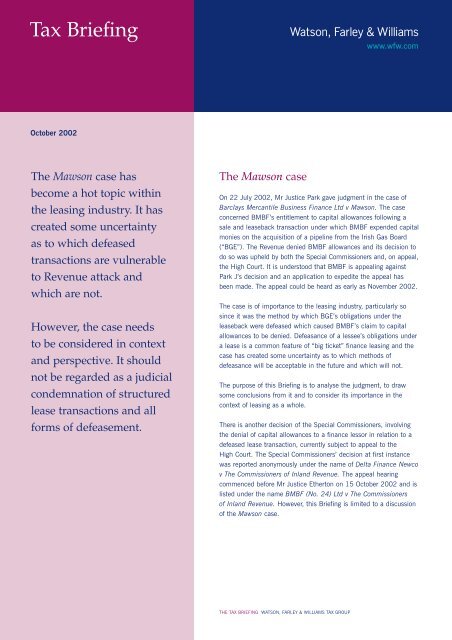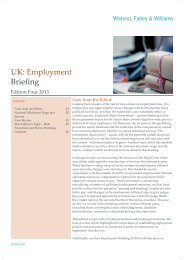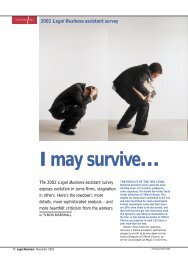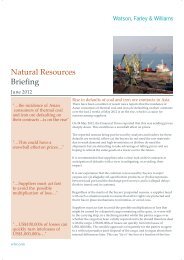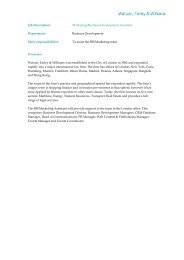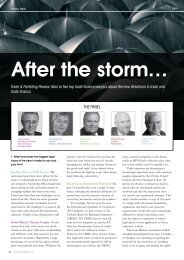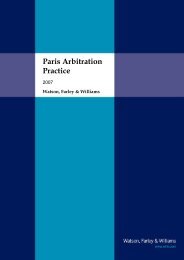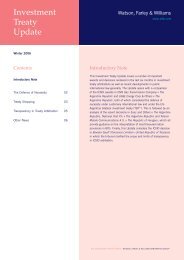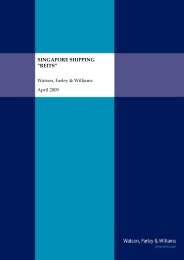Tax Briefing - Watson, Farley & Williams
Tax Briefing - Watson, Farley & Williams
Tax Briefing - Watson, Farley & Williams
You also want an ePaper? Increase the reach of your titles
YUMPU automatically turns print PDFs into web optimized ePapers that Google loves.
<strong>Tax</strong> <strong>Briefing</strong><br />
October 2002<br />
The Mawson case has<br />
become a hot topic within<br />
the leasing industry. It has<br />
created some uncertainty<br />
as to which defeased<br />
transactions are vulnerable<br />
to Revenue attack and<br />
which are not.<br />
However, the case needs<br />
to be considered in context<br />
and perspective. It should<br />
not be regarded as a judicial<br />
condemnation of structured<br />
lease transactions and all<br />
forms of defeasement.<br />
The Mawson case<br />
On 22 July 2002, Mr Justice Park gave judgment in the case of<br />
Barclays Mercantile Business Finance Ltd v Mawson. The case<br />
concerned BMBF’s entitlement to capital allowances following a<br />
sale and leaseback transaction under which BMBF expended capital<br />
monies on the acquisition of a pipeline from the Irish Gas Board<br />
(“BGE”). The Revenue denied BMBF allowances and its decision to<br />
do so was upheld by both the Special Commissioners and, on appeal,<br />
the High Court. It is understood that BMBF is appealing against<br />
Park J’s decision and an application to expedite the appeal has<br />
been made. The appeal could be heard as early as November 2002.<br />
The case is of importance to the leasing industry, particularly so<br />
since it was the method by which BGE’s obligations under the<br />
leaseback were defeased which caused BMBF’s claim to capital<br />
allowances to be denied. Defeasance of a lessee’s obligations under<br />
a lease is a common feature of “big ticket” finance leasing and the<br />
case has created some uncertainty as to which methods of<br />
defeasance will be acceptable in the future and which will not.<br />
The purpose of this <strong>Briefing</strong> is to analyse the judgment, to draw<br />
some conclusions from it and to consider its importance in the<br />
context of leasing as a whole.<br />
There is another decision of the Special Commissioners, involving<br />
the denial of capital allowances to a finance lessor in relation to a<br />
defeased lease transaction, currently subject to appeal to the<br />
High Court. The Special Commissioners’ decision at first instance<br />
was reported anonymously under the name of Delta Finance Newco<br />
v The Commissioners of Inland Revenue. The appeal hearing<br />
commenced before Mr Justice Etherton on 15 October 2002 and is<br />
listed under the name BMBF (No. 24) Ltd v The Commissioners<br />
of Inland Revenue. However, this <strong>Briefing</strong> is limited to a discussion<br />
of the Mawson case.<br />
THE TAX BRIEFING WATSON, FARLEY & WILLIAMS TAX GROUP
FINANCE LEASING OR A “...COMPLICATED CONVOLUTED<br />
TAX AVOIDANCE TRANSACTION...”<br />
Facts<br />
At material times prior to 31 December 1993, BGE was the<br />
owner of a natural gas pipeline which runs from Scotland to<br />
the Irish Republic. The net cost to BGE of the pipeline,<br />
after deducting the benefit of grants from (what is now) the<br />
European Union, was approximately £91m.<br />
On 31 December 1993, the following transactions took place:<br />
Barclays Bank lent approximately £91m to its leasing<br />
subsidiary, BMBF.<br />
BMBF purchased the pipeline from BGE for approximately<br />
£91m and leased it back to BGE for an initial period of a little<br />
under 33 years, plus a possible secondary period. The initial<br />
period was divided into a pre-primary period of a little under<br />
two years and a primary period of 31 years. A modest fixed<br />
rent was payable during the pre-primary period. The rent<br />
reserved during the primary period had a profile not untypical<br />
of a tax based finance lease with escalating rentals. It was<br />
structured to enable BMBF to recover its capital cost on the<br />
pipeline plus a margin over that period after taking account of<br />
funding costs and the benefit of group relief receipts arising<br />
from the surrender of losses derived from capital allowances<br />
to other companies in the Barclays Bank group.<br />
BGE sub-leased the pipeline to its wholly owned UK subsidiary,<br />
namely BGE (UK). The terms of the sub-lease were broadly<br />
similar to those in the lease, although, unlike the lease, the<br />
rentals were not variable as a result of a change of tax<br />
assumption. Although the rental profile equated to that under the<br />
lease at inception, the sub-lease rental profile would diverge from<br />
that under the lease in the event of rental adjustments under the<br />
lease consequent upon (inter alia) a change of tax assumption.<br />
Deepstream applied monies deposited with it in making a<br />
deposit with Barclays IOM, a subsidiary of Barclays Bank in the<br />
Isle of Man.<br />
In accordance with Barclays Bank’s group policy, Barclays IOM<br />
applied the monies deposited with it by Deepstream in making<br />
a deposit with Barclays Bank group treasury.<br />
BGE entered into a Transportation Agreement with BGE (UK)<br />
under which the latter company agreed to transport gas for BGE<br />
for a fee. Although the fee payable was to be calculated in<br />
accordance with a formula, it incorporated a minimum amount<br />
which would be payable in any event and which would never<br />
be less than the amount which BGE (UK) was required to pay<br />
in rent under the sub-lease.<br />
BMBF, BGE and BGE (UK) entered into an Assumption<br />
Agreement under which BGE (UK) would pay an amount equal<br />
to the rent due to BGE under the sublease direct to BMBF in<br />
satisfaction (wholly or in part) of BGE’s obligations to pay rent<br />
under the lease. The Assumption Agreement further provided<br />
how such payments would be modified in the event that the<br />
rentals due from BGE to BMBF under the lease altered as a<br />
consequence of changes in assumption.<br />
Barclays Bank guaranteed to BMBF that BGE (UK) would make<br />
payments to it under the Assumption Agreement. Deepstream<br />
agreed to indemnify Barclays Bank against any liabilities<br />
incurred by it under the guarantee and charged its deposit with<br />
Barclays IOM in favour of Barclays Bank, in support thereof.<br />
BGE charged its deposit with Deepstream in favour of BGE<br />
(UK) to secure its obligations to make payments to BGE (UK)<br />
under the Transportation Agreement.<br />
BGE deposited the proceeds of sale of the pipeline with a<br />
Jersey company called Deepstream. Although Deepstream was<br />
an “orphan” company owned by a charitable trust, it was<br />
managed by Barclays Bank.<br />
THE TAX BRIEFING WATSON, FARLEY & WILLIAMS TAX GROUP 02
THERE WAS A CASHFLOW CIRCUIT WHICH THE<br />
SPECIAL COMMISSIONERS FOUND, AS A MATTER<br />
OF FACT, WAS PRE-ORDAINED AND DESIGNED AS<br />
A COMPOSITE WHOLE.<br />
Cashflows<br />
The effect of the foregoing is that upon the origination of the<br />
arrangements on 31 December 1993, the £91m emanating<br />
from Barclays Bank passed:<br />
from Barclays Bank to BMBF by way of loan<br />
from BMBF to BGE as purchase price for the pipeline<br />
from BGE to Deepstream by way of deposit<br />
from Deepstream to Barclays IOM by way of deposit<br />
from Barclays IOM to Barclays Bank by way of deposit.<br />
There was a cashflow circuit which the Special Commissioners<br />
found, as a matter of fact, was pre-ordained and designed as a<br />
composite whole.<br />
During the primary period of the lease, the cashflows would<br />
reverse year by year in accordance with a pre-ordained formulation.<br />
monies would be released by Barclays Bank from the deposit<br />
with it to Barclays IOM<br />
Barclays IOM would release an equivalent sum from the<br />
deposit with it to Deepstream<br />
Deepstream would release an equivalent sum to BGE.<br />
The releases from the Deepstream deposit comprised three<br />
elements known as the A, B and C amounts. The A amount<br />
was structured so as to equate to BGE (UK)’s rental liability<br />
year by year under the sub-lease<br />
Deepstream would, presumably at the direction of BGE, pay<br />
the A amount to BGE (UK) in satisfaction of the minimum<br />
fee under the Transportation Agreement. (To the extent<br />
necessary, BGE would make top up payments to BGE (UK)<br />
in the event that the fees payable under the Transportation<br />
Agreement exceeded the minimum amount.) Deepstream<br />
would pay any B and C amounts to BGE<br />
BGE (UK) would apply its receipt in relation to the minimum<br />
fee paid under the Transportation Agreement in satisfying its<br />
rental obligations under the sub-lease. In this respect, in<br />
accordance with the Assumption Agreement, it would pay<br />
that sum direct to BMBF unless (following a change of tax<br />
assumption in the lease) the rentals under the lease had<br />
reduced, in which case BGE (UK) would pay a sum to BMBF<br />
sufficient to satisfy BGE’s rental obligations under the lease<br />
and would account to BGE for the excess. (If, following a<br />
change of tax assumption, BGE’s rental obligations under the<br />
lease exceeded that payable under the sub-lease, BGE<br />
would, in turn, be obliged to pay the shortfall to BMBF, but<br />
would have the B and C amounts released from the<br />
Deepstream deposit with which (at least in part) to meet<br />
that obligation)<br />
it is assumed that BMBF would apply the amounts received<br />
from BGE (UK) under the Assumption Agreement (and from<br />
BGE under the lease where relevant) in repaying principal<br />
and interest on its loan from Barclays Bank.<br />
Revenue’s contentions<br />
In order for BMBF to claim capital allowances it had to be able<br />
to satisfy the requirements of (inter alia) Section 24(1) Capital<br />
Allowances Act 1990 (now substantially re-enacted as Section<br />
11(4) Capital Allowances Act 2001). In particular, BMBF<br />
would have to be a trading company and would have to have:<br />
“…incurred capital expenditure on the provision of machinery or<br />
plant wholly and exclusively for the purposes of the trade…”.<br />
The Revenue contended that it was entitled to deny BMBF<br />
allowances for any of the following three reasons:<br />
having regard to the circularity of the cashflows, BMBF had<br />
not actually incurred any expenditure, in the sense of having<br />
borne expenditure<br />
if it had incurred expenditure, it was not upon the pipeline<br />
but upon acquiring the benefit of cashflows to be derived<br />
from the arrangements as a whole<br />
even if it had incurred expenditure on the pipeline,<br />
such expenditure had not been incurred for the purposes<br />
of its leasing trade but upon an exercise of<br />
“…financial engineering…”.<br />
THE TAX BRIEFING WATSON, FARLEY & WILLIAMS TAX GROUP 03
THE JUDGE AGREED THAT THE MONIES EXPENDED<br />
BY BMBF WERE NOT UPON THE PIPELINE BUT UPON<br />
“…MONEY FLOWS…” TO BE DERIVED FROM AN<br />
EXERCISE OF “…FINANCIAL ENGINEERING…”.<br />
The judgment<br />
A majority of Park J’s judgment was devoted to analysing the<br />
second of the Revenue’s arguments since that was the principal<br />
argument advanced. The Judge, in dismissing BMBF’s appeal:<br />
Agreed that the monies expended by BMBF were not upon the<br />
pipeline but upon “…money flows…” to be derived from an<br />
exercise of “…financial engineering…”.<br />
Agreed that, when one analysed the arrangements in their<br />
entirety, BMBF’s involvement in the arrangements had not<br />
been in pursuance of its normal leasing trade. Although he<br />
accepted that a trading activity could not be denatured<br />
purely because fiscal benefits would be derived therefrom, in<br />
his view the transactions were “…heavily dominated by fiscal<br />
elements…”, to such an extent that (applying Megarry J’s<br />
test in Lupton v FA & AB Ltd) it could not be said that BMBF’s<br />
involvement in the arrangements was in pursuance of trade.<br />
Tended to the view that BMBF had incurred capital<br />
expenditure, although he acknowledged that where there is a<br />
circulation of money difficult issues can arise largely due to<br />
the existence of apparently conflicting judicial authorities.<br />
In reaching his conclusion the Judge:<br />
Accepted that in analysing whether BMBF was entitled to<br />
allowances he was required to consider all of the arrangements<br />
as a whole and was not restricted to considering solely those<br />
elements of the arrangements to which BMBF was a<br />
contractual party. The fact that BMBF did not know the<br />
precise detail of those parts of the structure to which it was<br />
not a party would not preclude an examination of the<br />
arrangements in their entirety, particularly so since BMBF<br />
was aware that the arrangements involved a fully<br />
collateralised financing.<br />
Rejected the Special Commissioners’ assertion that in order for<br />
the Revenue to defend BMBF’s appeal successfully it would<br />
have to establish that the arrangements amounted to “…a<br />
complicated, convoluted tax avoidance transaction…”. In this<br />
respect, Park J considered that the role of the Court was to<br />
analyse the “…real…” (a word to which he referred extensively<br />
in his judgment) effect of the arrangements with a view to<br />
determining whether they enabled the statutory provisions,<br />
upon which BMBF’s claim to allowances depended, to be<br />
satisfied, giving the words of the relevant statutory provisions<br />
their commercial (as opposed to purely juristic) meaning, such<br />
method of construction being consistent with the approach<br />
prescribed by the House of Lords in MacNiven v Westmoreland<br />
Investments Ltd.<br />
Regarded the security arrangements as a critical issue.<br />
In particular, he considered the method of internal defeasance<br />
under which monies expended by BMBF had to be applied<br />
in a comprehensive pre-ordained security “loop”, in order to<br />
collateralise BGE’s obligations to it under the lease, led to<br />
the conclusion that BMBF had not incurred expenditure on<br />
the pipeline, but had embarked upon an exercise of<br />
“…financial engineering…”.<br />
As Park J put it:<br />
“…I accept that finance lessors always wish to limit the credit<br />
risk to which they are exposed. But there can be cases where<br />
the credit risk is so comprehensively eliminated that it becomes<br />
apparent, if one steps back and thinks about it, that the lessor<br />
has not really laid out its money on a leasing transaction at all…”.<br />
THE TAX BRIEFING WATSON, FARLEY & WILLIAMS TAX GROUP 04
“…FINANCE LESSORS ALWAYS WISH TO LIMIT CREDIT RISK<br />
...BUT THERE CAN BE CASES WHERE THE CREDIT RISK IS SO<br />
COMPREHENSIVELY ELIMINATED THAT IT BECOMES APPARENT<br />
...THAT THE LESSOR HAS NOT REALLY LAID OUT ITS MONEY<br />
ON A LEASING TRANSACTION AT ALL…” PARK J.<br />
Although the security “loop” was circular and all parties thereto<br />
were effectively controlled by Barclays Bank (albeit that<br />
Deepstream was not a member of the Barclays corporate<br />
group), the Judge implied that his conclusion would not have<br />
been different had the security arrangements been “…linear…”<br />
rather than circular. In other words, it would not have affected<br />
his decision if the monies derived from the sale of the pipeline<br />
had, as part of pre-ordained arrangements, been deposited with<br />
an independent bank (rather than, indirectly, with Barclays<br />
Bank) which, in turn, was obliged to provide both security for<br />
BGE’s obligations under the lease and the funds to enable<br />
rentals to be paid (wholly or substantially/directly or indirectly)<br />
in the form of releases from the security deposit.<br />
Placed importance on the fact that, given the transaction<br />
between BGE and BMBF was that of sale and leaseback,<br />
“…BGE could not get its hands on the money…” i.e. the<br />
proceeds of sale of the pipeline. A characteristic of expenditure<br />
being incurred on plant and machinery in the course of a<br />
leasing trade is that the price paid by the lessor for the<br />
relevant asset should either be available to the lessee for use<br />
in its business, where the transaction is structured as a sale<br />
and leaseback, or, presumably, should be applied in relieving<br />
the lessee of expenditure it would otherwise have had to pay<br />
in order to obtain the use of the asset, where the lessor<br />
acquires the asset direct from a third party, such as a<br />
manufacturer. In essence, the lessor must provide “…up<br />
front…” finance which is either made available to the<br />
lessee or applied for its benefit.<br />
Concluded that the security arrangements prevented BGE from<br />
realising monies on the sale of the pipeline which it was then<br />
free to deal with as it wished in the course of its business.<br />
(Clearly, since BGE already owned the pipeline at the time<br />
of the sale and leaseback, there was no question of BMBF’s<br />
money being applied on the purchase of the pipeline from a<br />
third party.)<br />
Placed some significance on the fact that no attempt was<br />
made to attribute a true value to the pipeline for the purposes<br />
of determining the price at which it was sold to BMBF. That<br />
factor suggested that, apart from the ability to generate capital<br />
allowances, the pipeline was not particularly relevant to the<br />
arrangements as a whole, leading to the conclusion that<br />
BMBF’s expenditure was not on the pipeline but upon the<br />
“…cashflows…” to be derived from the “…financial engineering…”<br />
constituted thereby.<br />
Distinguished the arrangements under review from those in<br />
a conventional funding by means of lease finance. The Judge<br />
noted “…this case is exceptional and possesses unusual<br />
features which differentiate it from the general run of BMBF’s<br />
finance leasing…”. In a conventional finance lease, the lessee<br />
enjoys a lower funding cost as a result of the lessor’s claim to<br />
capital allowances being factored into the calculation of the<br />
lease rentals. In the case under review, BGE did not enjoy a<br />
lower funding cost since no new monies were made available<br />
to pay off the existing banking syndicate which had financed<br />
BGE’s acquisition of the pipeline in the first instance.<br />
The benefit to BGE of the arrangements was the B and C<br />
amounts released periodically from the Deepstream deposit;<br />
such payments represented BGE’s share of the fiscal<br />
benefits to be derived from the arrangements but, in the<br />
absence of new funding, the payment of such monies was,<br />
as Park J observed: “…not remotely characteristic of<br />
finance leasing…”.<br />
THE TAX BRIEFING WATSON, FARLEY & WILLIAMS TAX GROUP 05
...IT IS APPARENT THAT IT IS NOT THE FACT<br />
THAT BGE’S OBLIGATIONS UNDER THE LEASE<br />
WERE SECURED WHICH THE JUDGE FOUND<br />
OFFENSIVE BUT THE METHOD BY WHICH THEY<br />
WERE DEFEASED...<br />
Comment<br />
The Barclays case should not be regarded as a general attack<br />
on leasing nor, as a general proposition, as an attack on<br />
structured financial arrangements, even where those<br />
arrangements are fiscally motivated i.e. designed to enable a<br />
tax benefit to be derived therefrom. Indeed, there are a number<br />
of passages in the judgment which clearly demonstrate that<br />
Park J does not find structured leasing offensive, nor the fact<br />
that, as he puts it: “…careful tax planning is always<br />
involved…”. In particular, the Judge notes:<br />
“ …As regards finance leasing the underlying purpose of<br />
Parliament, in my view, is to enable capital allowances to be<br />
used so as to provide to lessees at attractive rates finance for<br />
them to use or to develop their real business activities…”.<br />
Furthermore, the case should not be regarded as a general<br />
attack upon defeasance in the context of lease arrangements.<br />
Again, there are passages in the judgment in which Park J<br />
clearly accepts that lessors wish to limit the credit risk to which<br />
they are exposed and that they commonly require lessee’s<br />
obligations to be secured by a bank guarantee or other method<br />
of security. He also acknowledges that where a bank provides<br />
security to a lessor in relation to a lessee’s obligations under a<br />
lease, the bank usually wishes to secure its own position by<br />
counter guarantees and indemnities or, presumably, other forms<br />
of security.<br />
In the Mawson case, it is apparent that it is not the fact<br />
that BGE’s obligations under the lease were secured which<br />
the Judge found offensive but the method by which they<br />
were defeased.<br />
In any event, certain types of defeasance are specifically<br />
permitted by statute in the case of finance leases to lessees<br />
who are in tonnage tax.<br />
Acceptable and unacceptable<br />
defeasance<br />
Based upon Park J’s comments and his analysis in the Mawson<br />
case, as a general proposition, there is no reason to believe that<br />
there is anything objectionable to the defeasance of a lessee’s<br />
obligations under a lease where a letter of credit (or other form<br />
of contractual security) is provided to the lessor by a third party<br />
bank, in circumstances in which the letter of credit is supported<br />
by a deposit made with the third party bank emanating either<br />
from funds freely available to the lessee (or a member of its<br />
group) or from a source which is independent of the lessor.<br />
That being the case, a typical security arrangement under<br />
which a third party bank (independent of the lessor) lends<br />
money to the lessee which is deposited with a defeasance bank<br />
who, in turn, issues a letter of credit in favour of the lessor, to<br />
secure the lessee’s obligations under the relevant lease, should<br />
not cause the Revenue to deny the lessor capital allowances.<br />
That should be the case even where, typically, the third party<br />
bank takes a charge over the relevant asset to secure the<br />
payment to it, by the lessee, of any rebate of hire consequent<br />
upon a sale of the asset following a termination of the lease.<br />
In the foregoing example, it is clear that the funds required to<br />
support the letter of credit issued by the defeasance bank do not<br />
emanate directly or indirectly from the lessor. This is because there<br />
are two separate sources of cash: one provided by the lessor under<br />
the lease and one which is provided by the third party bank.<br />
The defeasance arrangements which are likely to result in the<br />
greatest risk of the lessor’s allowances being denied are those in<br />
which money emanating from the lessor is applied in providing<br />
both the security for, and the method of financing, the lessee’s<br />
rental obligations under the lease (i.e. circumstances akin to<br />
those in the Mawson case); they are not to be recommended.<br />
THE TAX BRIEFING WATSON, FARLEY & WILLIAMS TAX GROUP 06
WHILST, QUITE CLEARLY, CAUTION NEEDS TO BE<br />
EXERCISED FOLLOWING THE MAWSON DECISION,<br />
...THE CASE NEEDS TO BE CONSIDERED IN CONTEXT<br />
AND PERSPECTIVE.<br />
However, between those two extremes there are a number of<br />
defeasance structures in respect of which the position is now<br />
somewhat less certain than was hitherto the case, in view of<br />
Park J’s comments in the Mawson case, some of which are less<br />
vulnerable than others.<br />
Would, for example, a lessor’s claim to allowances be denied if,<br />
in the case of a sale and leaseback, the proceeds of sale of the<br />
asset are used to provide a security deposit with a defeasance<br />
bank which, in turn, issues a letter of credit to the lessor to<br />
secure the lessee’s obligations under the lease<br />
Perhaps the analysis, and the answer to the question, will<br />
depend upon whether or not it is contemplated that the<br />
defeasance bank will release funds from the deposit, on a<br />
periodic basis, to enable the lessee to meet its rental<br />
obligations under the lease. If the arrangements are so<br />
structured then, having regard to Park J’s comment that his<br />
decision would have been the same in the Mawson case if the<br />
transactions and cashflows had been “…linear…” (i.e. where<br />
money emanating from the lessor passes into the hands of a<br />
banking group which is independent of the lessor) as opposed<br />
to circular, a risk must exist that allowances would be denied.<br />
However, if it is contemplated that the lease rentals will be<br />
funded separately and will not depend upon releases from<br />
the deposit with the defeasance bank, it may be possible to<br />
distinguish such circumstances from those which pertained in<br />
the Mawson case. In particular, the monies necessary to meet<br />
the lessee’s obligations will not originate (directly or indirectly)<br />
from the lessor except, possibly, in a default situation in which<br />
the letter of credit is called. A further distinguishing feature is<br />
that the lessor (or a company in its group) does not “control”<br />
the cash deposit and is exposed, in a default situation, to the<br />
credit risk of the defeasance bank, a situation very different<br />
from that in the Mawson case.<br />
Would the analysis be different if, in a sale and leaseback<br />
scenario, monies emanating from the lessor were applied in<br />
repaying interim finance required to fund the asset, with the<br />
lessee then drawing down a further loan to provide the security<br />
deposit with the defeasance bank Moreover, does it matter if<br />
the further drawdown is from the same source which provided<br />
the interim funding or must it be from an independent source<br />
and/or must the further drawdown be on different terms from<br />
that of the interim funding In his judgment, Park J recognised<br />
that a lessor should be treated as incurring expenditure on plant<br />
and machinery in the course of its leasing trade where “…up<br />
front monies…” are applied in refinancing an asset; in those<br />
circumstances, the lessee is able to use the monies so<br />
generated in its business to relieve it of an existing liability.<br />
It should not necessarily be concluded that all security arrangements<br />
which result in the lessee applying cash proceeds derived from a<br />
leasing transaction to support security which is, in turn, provided<br />
to the lessor to secure the lessee’s obligations, will render the<br />
lessor vulnerable to a denial of allowances. Whilst, quite clearly,<br />
caution needs to be exercised following the Mawson decision,<br />
and each situation needs to be considered on its merits by<br />
reference to the specific facts pertaining, the Mawson case needs<br />
to be considered in context and perspective. That case related to<br />
a particular set of circumstances which, arguably, provided<br />
greater opportunity for the Revenue to challenge than in the<br />
majority of cases where a lessee’s obligations are defeased.<br />
There is clearly less scope for the Revenue to challenge<br />
defeasance arrangements where the lessor’s expenditure on<br />
the asset is paid to a third party (e.g. a manufacturer), since in<br />
those circumstances there is little scope for the Revenue<br />
to argue that monies emanating from the lessor are applied in<br />
providing security for, and the funds with which to meet, the<br />
lessee’s obligations under the lease.<br />
Conclusion<br />
The Mawson case should not be regarded as a general attack<br />
on all defeased leasing but merely upon the method adopted in<br />
that case.<br />
THE TAX BRIEFING WATSON, FARLEY & WILLIAMS TAX GROUP 07
If you wish to discuss this briefing, please do not hesitate to<br />
contact us.<br />
Christopher Preston<br />
cpreston@wfw.com<br />
+44 (0) 020 7814 8005<br />
Michael L’Estrange<br />
mestrange@wfw.com<br />
+44 (0) 020 7814 8046<br />
<strong>Watson</strong>, <strong>Farley</strong> & <strong>Williams</strong><br />
15 Appold Street<br />
London EC2A 2HB<br />
Tel: +44 (0) 20 7814 8000<br />
Fax: +44 (0) 20 7814 8141/2<br />
www.wfw.com<br />
Chris Comyn<br />
ccomyn@wfw.com<br />
+44 (0) 020 7814 8025<br />
WATSON, FARLEY & WILLIAMS LONDON ATHENS PARIS NEW YORK SINGAPORE BANGKOK ROME<br />
This brochure is produced by <strong>Watson</strong>, <strong>Farley</strong> & <strong>Williams</strong>. It provides a summary of the legal issues, but is not intended to give specific legal advice. The situations described may not apply to your circumstances.<br />
If you require advice or have questions or comments on its subject, please speak to your usual contact at <strong>Watson</strong>, <strong>Farley</strong> & <strong>Williams</strong>.


